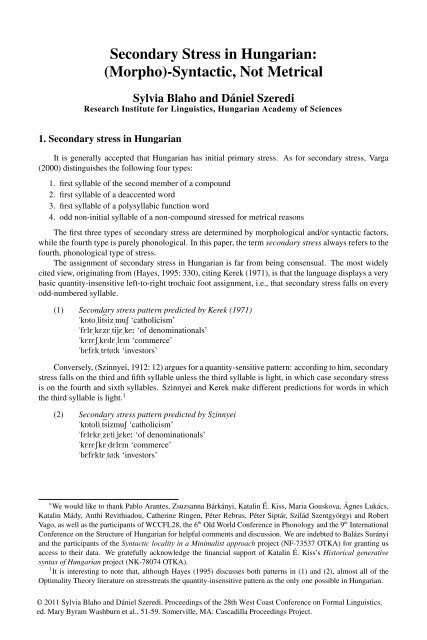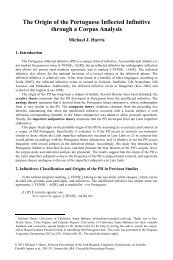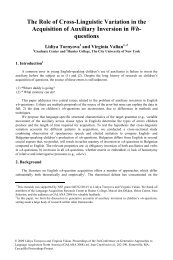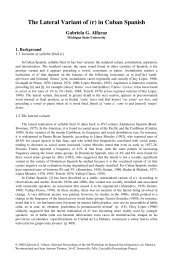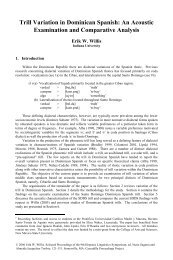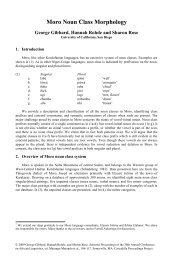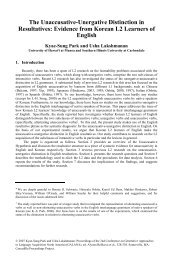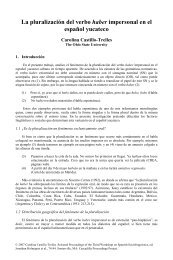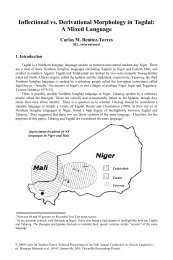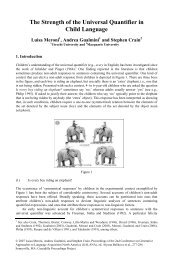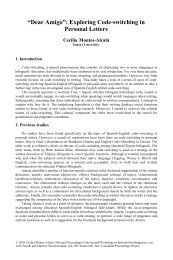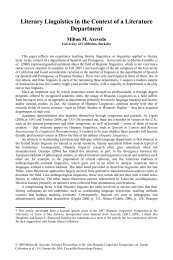Secondary Stress in Hungarian: (Morpho)-Syntactic, Not Metrical
Secondary Stress in Hungarian: (Morpho)-Syntactic, Not Metrical
Secondary Stress in Hungarian: (Morpho)-Syntactic, Not Metrical
Create successful ePaper yourself
Turn your PDF publications into a flip-book with our unique Google optimized e-Paper software.
<strong>Secondary</strong> <strong>Stress</strong> <strong>in</strong> <strong>Hungarian</strong>:<br />
(<strong>Morpho</strong>)-<strong>Syntactic</strong>, <strong>Not</strong> <strong>Metrical</strong><br />
SylviaBlahoandDanielSzeredi<br />
´<br />
Research Institute for L<strong>in</strong>guistics, <strong>Hungarian</strong> Academy of Sciences<br />
1. <strong>Secondary</strong> stress <strong>in</strong> <strong>Hungarian</strong><br />
It is generally accepted that <strong>Hungarian</strong> has <strong>in</strong>itial primary stress. As for secondary stress, Varga<br />
(2000) dist<strong>in</strong>guishes the follow<strong>in</strong>g four types:<br />
1. first syllable of the second member of a compound<br />
2. first syllable of a deaccented word<br />
3. first syllable of a polysyllabic function word<br />
4. odd non-<strong>in</strong>itial syllable of a non-compound stressed for metrical reasons<br />
The first three types of secondary stress are determ<strong>in</strong>ed by morphological and/or syntactic factors,<br />
while the fourth type is purely phonological. In this paper, the term secondary stress always refers to the<br />
fourth, phonological type of stress.<br />
The assignment of secondary stress <strong>in</strong> <strong>Hungarian</strong> is far from be<strong>in</strong>g consensual. The most widely<br />
cited view, orig<strong>in</strong>at<strong>in</strong>g from (Hayes, 1995: 330), cit<strong>in</strong>g Kerek (1971), is that the language displays a very<br />
basic quantity-<strong>in</strong>sensitive left-to-right trochaic foot assignment, i.e., that secondary stress falls on every<br />
odd-numbered syllable.<br />
(1) <strong>Secondary</strong> stress pattern predicted by Kerek (1971)<br />
"k6toli > tsizmuS ‘catholicism’<br />
"fElEkEzEtijEke: ‘of denom<strong>in</strong>ationals’<br />
"kErESkEdElEm ‘commerce’<br />
"bEfEktEtø:k ‘<strong>in</strong>vestors’<br />
Conversely, (Sz<strong>in</strong>nyei, 1912: 12) argues for a quantity-sensitive pattern: accord<strong>in</strong>g to him, secondary<br />
stress falls on the third and fifth syllable unless the third syllable is light, <strong>in</strong> which case secondary stress<br />
is on the fourth and sixth syllables. Sz<strong>in</strong>nyei and Kerek make different predictions for words <strong>in</strong> which<br />
the third syllable is light. 1<br />
(2) <strong>Secondary</strong> stress pattern predicted by Sz<strong>in</strong>nyei<br />
"k6toli > tsizmuS ‘catholicism’<br />
"fElEkEzEtijEke: ‘of denom<strong>in</strong>ationals’<br />
"kErESkEdElEm ‘commerce’<br />
"bEfEktEtø:k ‘<strong>in</strong>vestors’<br />
∗ We would like to thank Pablo Arantes, Zsuzsanna Bárkányi, Katal<strong>in</strong> É. Kiss, Maria Gouskova, Ágnes Lukács,<br />
Katal<strong>in</strong> Mády, Anthi Revithiadou, Cather<strong>in</strong>e R<strong>in</strong>gen, Péter Rebrus, Péter Siptár, Szilád Szentgyörgyi and Robert<br />
Vago, as well as the participants of WCCFL28, the 6 th Old World Conference <strong>in</strong> Phonology and the 9 th International<br />
Conference on the Structure of <strong>Hungarian</strong> for helpful comments and discussion. We are <strong>in</strong>debted to Balázs Surányi<br />
and the participants of the <strong>Syntactic</strong> locality <strong>in</strong> a M<strong>in</strong>imalist approach project (NF-73537 OTKA) for grant<strong>in</strong>g us<br />
access to their data. We gratefully acknowledge the f<strong>in</strong>ancial support of Katal<strong>in</strong> É. Kiss’s Historical generative<br />
syntax of <strong>Hungarian</strong> project (NK-78074 OTKA).<br />
1 It is <strong>in</strong>terest<strong>in</strong>g to note that, although Hayes (1995) discusses both patterns <strong>in</strong> (1) and (2), almost all of the<br />
Optimality Theory literature on stresstreats the quantity-<strong>in</strong>sensitive pattern as the only one possible <strong>in</strong> <strong>Hungarian</strong>.<br />
© 2011 Sylvia Blaho and Dániel Szeredi. Proceed<strong>in</strong>gs of the 28th West Coast Conference on Formal L<strong>in</strong>guistics,<br />
ed. Mary Byram Washburn et al., 51-59. Somerville, MA: Cascadilla Proceed<strong>in</strong>gs Project.
52<br />
F<strong>in</strong>ally, Hammond (1987) argues for a secondary vs. tertiary stress dist<strong>in</strong>ction. He <strong>in</strong>troduces an<br />
extra metrical tier, the colon tier, which gives more prom<strong>in</strong>ence to odd-numbered non-primary feet. In<br />
(3), tertiary stress is <strong>in</strong>dicated by the symbol Ť.<br />
(3) <strong>Secondary</strong> stress pattern predicted by Hammond (1987)<br />
"k6toli > tsizmuS ‘catholicism’<br />
"fElEkEŤzEtijEke: ‘of denom<strong>in</strong>ationals’<br />
"kErESkEdElEm ‘commerce’<br />
"bEfEktEtø:k ‘<strong>in</strong>vestors’<br />
"fe:lEŤmElEtEid ‘your mezzan<strong>in</strong>es’<br />
"kiSkunŤfe:lEéha:za:Ťb6n ‘<strong>in</strong> Kiskunfélegyháza’ (proper name)<br />
"Elka:Ťposta:Si:tot:Ť6l6ni:tot:Ťa:tok ‘you (pl.) have decabbagized it’ (sic!)<br />
Even though the existence of secondary stress has rarely been questioned <strong>in</strong> the literature, empirical<br />
evidence support<strong>in</strong>g it is not easy to come by. The authors of this paper (both native speakers of<br />
<strong>Hungarian</strong>) have no <strong>in</strong>tuition regard<strong>in</strong>g non-primary stress, and an impressionistic survey (<strong>in</strong>volv<strong>in</strong>g<br />
cca. 40 native speakers aged 20–34) yielded the same results.<br />
Moreover, as argued by Kálmán&Nádasdy (1994), there is no phonological evidence for secondary<br />
stress: there are no phonological patterns that are sensitive to the placement of putative secondary stress<br />
<strong>in</strong> <strong>Hungarian</strong>.<br />
Last, but by no means least, there is no phonetic proof for secondary stress, either. Although Varga<br />
(2000) states that “the phonetic reality of <strong>Hungarian</strong> secondary stress is not questioned” [a magyar<br />
mellékhangsúly fonetikai realitását nem vonják kétségbe], we found no studies describ<strong>in</strong>g acoustic or<br />
articulatory correlates of secondary stress <strong>in</strong> <strong>Hungarian</strong>.<br />
In the rema<strong>in</strong>der of this paper, we exam<strong>in</strong>e possible phonological and phonetic evidence for<br />
<strong>Hungarian</strong> secondary stress. In section 2, we discuss a phonological phenomenon that is argued to<br />
be sensitive to the placement of secondary stress by Varga (2000), while section 3 presents the results of<br />
our pilot study on the phonetics of <strong>Hungarian</strong> secondary stress.<br />
2. Phonological evidence for secondary stress?<br />
Varga (2000) uses a rule-based, multi-level model of stress assignment, where only primary stress<br />
is assigned on the lexical level. <strong>Secondary</strong> stress is assigned post-lexically, with<strong>in</strong> the doma<strong>in</strong> the<br />
phonological phrase. However, an even later, optional deletion rule can elim<strong>in</strong>ate any secondary stress.<br />
If any secondary stress can be erased before it is ever phonetically realised, how can one be sure that it<br />
was there <strong>in</strong> the first place?<br />
2.1. The ‘patronis<strong>in</strong>g’ <strong>in</strong>tonation pattern<br />
The central claim of Varga (2002) is that, contra Kálmán & Nádasdy (1994), there is a phonological<br />
process that is sensitive to the placement of secondary stress: the alignment of the so-called ‘patronis<strong>in</strong>g’<br />
<strong>in</strong>tonation pattern. Varga describes the use of this <strong>in</strong>tonation pattern as follows.<br />
[. . . it expresses the fact that the speaker considers the content of the sentence to be selfevident<br />
(obvious, natural, predictable, etc.). At the same time, this melody conveys the <strong>in</strong>tellectual<br />
or adm<strong>in</strong>istrative superiority of the speaker, therefore it can simultaneously express a paternalis<strong>in</strong>g and<br />
categorical attitude, but it is not unfriendly.]<br />
Varga (2002)<br />
As for its phonological shape, the ‘patronis<strong>in</strong>g’ <strong>in</strong>tonation pattern consists of a fall–high–fall<br />
melody. Accord<strong>in</strong>g to Varga, it is derived from a neutral sentence by <strong>in</strong>sert<strong>in</strong>g a high melody between<br />
the last and the penultimate fall<strong>in</strong>g contour of a sentence, and the <strong>in</strong>sertion of the high tone can only<br />
happen provided there are at least three syllables between the two fall<strong>in</strong>g melodies.<br />
The crux of Varga’s argument is that the high tone of the ‘patronis<strong>in</strong>g’ <strong>in</strong>tonation pattern can only<br />
associate with a syllable that has secondary stress. Thus, (4b) is a grammatical ‘patronis<strong>in</strong>g’ variant of<br />
the neutral sentence <strong>in</strong> (4a), but (4c) is not.
(4) a. Neutral <strong>in</strong>tonation<br />
ba-<br />
A nem<br />
rátaival<br />
beszél így.<br />
b. ‘Patronis<strong>in</strong>g’ <strong>in</strong>tonation (grammatical):<br />
ba- taival<br />
A nem<br />
rábeszél<br />
így.<br />
c. ‘Patronis<strong>in</strong>g’ <strong>in</strong>tonation (ungrammatical):<br />
ba- ival<br />
A nem<br />
rátabeszél<br />
így.<br />
‘He doesn’t speak to his friends like this.’<br />
To support the hypothesis that the difference between the acceptability of (4b) and (4c) is due to the<br />
placement of secondary stress, Varga conducted a perception experiment <strong>in</strong>volv<strong>in</strong>g 105 university and<br />
college students aged between 18 and 36. He made record<strong>in</strong>gs of four sentences (shown <strong>in</strong> (5)) with the<br />
‘patronis<strong>in</strong>g’ <strong>in</strong>tonation pattern.<br />
(5) Test sentences of Varga (2000)<br />
a. A "barátaimnak "Jóska. ‘To my friends, I am Jóska.’<br />
b. A "barátaival "nem beszél így. ‘He doesn’t speak to his friends like this.’<br />
c. Ez egy "kiapadhatatlan "erőforrás. ‘This is an unfail<strong>in</strong>g resource.’<br />
d. "Kísérletezhetnétek egy "másikkal. ‘You (pl.) could experiment with a different<br />
one.’<br />
Each of the four sentences had variants with different placement of the <strong>in</strong>serted high melody. Three<br />
of the sentences (5a, b, and d) had light third syllables <strong>in</strong> the doma<strong>in</strong> where the <strong>in</strong>serted high tone (H)<br />
could potentially be placed (note that Kerek and Sz<strong>in</strong>nyei make different predictions for the secondary<br />
stress pattern of these sentences).<br />
The task of the experiment’s subjects was to mark each sentence as acceptable or unacceptable<br />
after listen<strong>in</strong>g to the record<strong>in</strong>g twice, and then to choose the best sentence from all four groups after a<br />
third round of listen<strong>in</strong>g. One po<strong>in</strong>t was assigned to every sentence that was judged acceptable, and an<br />
additional po<strong>in</strong>t was assigned to the sentences that were judged the best <strong>in</strong> their batch (i. e., the best<br />
‘patronis<strong>in</strong>g’ variant of the same neutral sentence) <strong>in</strong> the third round of listen<strong>in</strong>g. Crucially, sentences<br />
with the neutral <strong>in</strong>tonation pattern were not presented to the subjects.<br />
Of the four groups of sentences, three (5a, b, and c) showed a statistically significant preference for<br />
attach<strong>in</strong>g H to the third syllable. In the longest sentence, (5d), H could attach to either the fifth or the<br />
sixth syllable of the relevant doma<strong>in</strong>, and preferences for both syllables were significantly higher than for<br />
the other syllables. Varga suggests that the reason for this was that some speakers used the Sz<strong>in</strong>nyei-type<br />
dialect, assign<strong>in</strong>g secondary stress to the fourth and sixth syllable of the doma<strong>in</strong>.<br />
2.2. Varga (2000): problems<br />
Unfortunately, the ‘patronis<strong>in</strong>g’ <strong>in</strong>tonation pattern is miss<strong>in</strong>g from the grammar of both of the<br />
authors of this paper, so we cannot turn to our own judgements regard<strong>in</strong>g the grammaticality of each<br />
variant. We do, however, feel that both Varga’s experimental design and his <strong>in</strong>terpretation of the results<br />
raise doubts regard<strong>in</strong>g the connection between this <strong>in</strong>tonation pattern and secondary stress.<br />
First, sentences with neutral <strong>in</strong>tonation were not <strong>in</strong>cluded <strong>in</strong> experiment, which might well have<br />
shifted the basel<strong>in</strong>e for the acceptability of the ‘patronis<strong>in</strong>g’ sentences: we cannot exclude the possibility<br />
that at least some speakers would have judged all ‘patronis<strong>in</strong>g’ sentences unacceptable if contrasted with<br />
53
54<br />
their neutral counterparts. This suspicion is especially strong for the third round of listen<strong>in</strong>g where<br />
participants had to choose the best variant of each sentence.<br />
Award<strong>in</strong>g an extra po<strong>in</strong>t for the best variant <strong>in</strong> each batch had another undesirable consequence, we<br />
feel: it pushed differences between <strong>in</strong>dividual variants toward be<strong>in</strong>g statistically significant.<br />
However, even if we disregard these concerns, we believe that the results of the experiment are far<br />
from conclusive. First, it is not clear where the H attaches <strong>in</strong> case there is more than one secondary<br />
stressed syllable <strong>in</strong> the doma<strong>in</strong>. Varga stipulates that H cannot attach to the last syllable of the doma<strong>in</strong>,<br />
because that would create a clash. This, however, still does not expla<strong>in</strong> why the fifth syllable is preferred<br />
over the third <strong>in</strong> (5d).<br />
Moreover, the fact that the fifth and the sixth syllable achieved similarly good results for (5d) is quite<br />
difficult to expla<strong>in</strong>. If we follow Varga <strong>in</strong> assum<strong>in</strong>g that the experimental subjects conta<strong>in</strong>ed speakers<br />
that assigned secondary stress accord<strong>in</strong>g to Sz<strong>in</strong>nyei’s algorithm (stress<strong>in</strong>g the fourth and sixth syllables<br />
when the third was light), then the same speakers should have adopted the same algorithm for (5a) and<br />
(b) and attach the H to the fourth syllable <strong>in</strong>stead of the third. However, variants of (5a) and (b) with H<br />
on the fourth syllable got extremely low acceptability scores.<br />
If, on the other hand, speakers are assumed to be able to choose a different stress algorithm for<br />
different sentences, then the claim about the <strong>in</strong>tonation pattern be<strong>in</strong>g sensitive to secondary stress is<br />
unfalsifiable.<br />
3. Experiments<br />
3.1. Methodology<br />
In order to test if there is a phonetic realization of secondary stress <strong>in</strong> <strong>Hungarian</strong>, we carried out two<br />
acoustic experiments. Acoustic phonetic analysis was conducted to obta<strong>in</strong> results from the experiments<br />
us<strong>in</strong>g the Praat software (Boersma & Ween<strong>in</strong>k, 2008).<br />
Raphael et al. (2007) provide 3 phonetic correlates for the phonological notion of stress:<br />
• fundamental frequency (F0, pitch)<br />
• vowel duration<br />
• <strong>in</strong>tensity<br />
F0 <strong>in</strong> <strong>Hungarian</strong> is determ<strong>in</strong>ed by the <strong>in</strong>formation structure of the sentence (cf. Varga 2002)<br />
Vowel duration <strong>in</strong> <strong>Hungarian</strong> is only <strong>in</strong>fluenced by the lexical length contrast and local factors like<br />
follow<strong>in</strong>g sonorants. Vowel undershoot is l<strong>in</strong>ked to vowel duration and <strong>in</strong>tensity (L<strong>in</strong>dblom, 1963), but<br />
Szeredi (2009) shows that optional vowel reduction can happen <strong>in</strong> every non-primary-stressed syllable.<br />
Therefore, follow<strong>in</strong>g Varga, we assume vowel <strong>in</strong>tensity is the ma<strong>in</strong> cue for hypothetical secondary stress<br />
<strong>in</strong> <strong>Hungarian</strong>.<br />
Despite the above, we have checked the effect of all three cues <strong>in</strong> our experiments. The prosodic<br />
properties of the target vowels were measured at the po<strong>in</strong>t with the highest <strong>in</strong>tensity. The first three<br />
formants, fundamental frequency and <strong>in</strong>tensity were measured for every vowel <strong>in</strong> test words.<br />
Statistical analysis was carried out us<strong>in</strong>g the freeware R software (R Development Core Team,<br />
2009). The statistical measurement used to determ<strong>in</strong>e if a syllable was more salient <strong>in</strong> a given phonetic<br />
property (thus hav<strong>in</strong>g more stress) was pairwise t-test of the sample of values of this property <strong>in</strong><br />
neighbour<strong>in</strong>g syllables. This means that for every repetition for every speaker, values for each pair<br />
of neighbour<strong>in</strong>g syllables is assembled, and their difference δ is calculated. The t-test then provides the<br />
probability p that these δ values are sampled from a population with a mean μδ =0. Calculat<strong>in</strong>g with a<br />
95% confidence <strong>in</strong>terval, p
speaker repetition <strong>in</strong>tensity (dB) δ<br />
σ1 σ2 σ2 − σ1<br />
1 1 70.904 71.795 0.891<br />
1 2 73.052 73.524 0.472<br />
1 3 70.907 73.281 2.372<br />
2 1 61.551 63.766 2.215<br />
···<br />
mean 69.147 70.695 1.548<br />
t =4.367 with d.f. =8<br />
p ≈ 0.00239 ⇒ σ2 has significantly more <strong>in</strong>tensity than σ1<br />
Table 1: Illustration of the pairwise t-test (test word [fEl6d6tot]).<br />
<strong>in</strong> a casual environment, then they were asked to read the sentences twice as if they were <strong>in</strong> a formal<br />
situation to obta<strong>in</strong> data for formal speech as well.<br />
The quality of the record<strong>in</strong>gs for one of the speakers was unfortunately not adequate, therefore<br />
results will only be presented for the other speaker. The small sample size for this experiment obviously<br />
means that its result should not be taken as statistically significant, but these results had been encourag<strong>in</strong>g<br />
and had given reason for conduct<strong>in</strong>g the ma<strong>in</strong> experiment.<br />
This small scale prelim<strong>in</strong>ary study has shown, however, that of the three possible phonetic correlates<br />
of stress provided by Raphael et al. (2007: 232) and listed <strong>in</strong> section 3.1, vowel duration and vowel<br />
quality seem to be irrelevant for non-primary stress <strong>in</strong> <strong>Hungarian</strong>. Fundamental frequency is not relevant<br />
either, as it is clearly determ<strong>in</strong>ed by syntactic and pragmatic structure and every test word showed a<br />
strictly monotone fall<strong>in</strong>g pitch, as part of the post-verbal doma<strong>in</strong>.<br />
Therefore, we posit that vowel <strong>in</strong>tensity is the ma<strong>in</strong> cue for hypothetical secondary stress <strong>in</strong><br />
<strong>Hungarian</strong>. Our results <strong>in</strong>dicated that <strong>in</strong>tensity does not correlate with syllable weight. Elim<strong>in</strong>at<strong>in</strong>g<br />
<strong>in</strong>fluences of clause structure, words consist<strong>in</strong>g entirely of light syllables usually did not show secondary<br />
stress at all: the first syllable had the highest <strong>in</strong>tensity and the <strong>in</strong>tensity peaks on the follow<strong>in</strong>g vowels<br />
decreased gradually. If there was a slight <strong>in</strong>crease of <strong>in</strong>tensity, it was found <strong>in</strong> the place where Sz<strong>in</strong>nyei<br />
had predicted it.<br />
These results have encouraged further research <strong>in</strong>to the topic, and the <strong>in</strong>volvement of more test<br />
sentences, more speakers and better contextual control.<br />
3.3. Phonetic evidence for stress: the ma<strong>in</strong> pilot study<br />
In this study, seven test sentences from the record<strong>in</strong>gs for the Synactic locality project 2 were<br />
exam<strong>in</strong>ed. This experiment was conducted with six native speakers of Educated Colloquial <strong>Hungarian</strong>,<br />
who were <strong>in</strong>structed to focus on the mean<strong>in</strong>g of the sentence. The register used by the subjects, with<br />
the exception of one, was rather casual. Every sentence was read three times by each speaker, yield<strong>in</strong>g a<br />
sample size of 18 for each test word.<br />
Test sentences were selected accord<strong>in</strong>g to the phonological shape of the word follow<strong>in</strong>g the verb.<br />
As test words were <strong>in</strong> the post-verbal doma<strong>in</strong>, they were also post-focal, thus, each one had the same<br />
syntactic prosodic property, therefore difference <strong>in</strong> their stress pattern can only be attributed to lexical<br />
stress. Four test words had a heavy third syllable and three had a light third syllable, so that the Sz<strong>in</strong>nyeitype<br />
stress pattern could also be tested.<br />
Vowel duration was not measured <strong>in</strong> this experiment, as the results of the prelim<strong>in</strong>ary study<br />
demonstrated conv<strong>in</strong>c<strong>in</strong>gly that it is ma<strong>in</strong>ly the function of the lexical length contrast and neighbour<strong>in</strong>g<br />
consonants. These results have also shown that pitch is not relevant for the study of the<strong>Hungarian</strong> stress<br />
pattern: our statistical method shows that no syllable is significantly salient <strong>in</strong> pitch. Vowel quality is<br />
also a poor <strong>in</strong>dicator of secondary stress as it can be illustrated by the first formant values of the test<br />
word [rEndElkEze:SrE]. Our results <strong>in</strong>dicate that besides the first syllable, the second and the fifth are the<br />
2 The <strong>Syntactic</strong> locality <strong>in</strong> a M<strong>in</strong>imalist approach project (OTKA NF-73537) of the Research Institute for<br />
L<strong>in</strong>guistics, <strong>Hungarian</strong> Academy of Sciences, Project Manager Balázs Surányi.<br />
55
56<br />
least reduced, as the vowel /E/ tends to raise towards [I] <strong>in</strong> the <strong>Hungarian</strong> reduction pattern (cf. Szeredi,<br />
2009). This would mean that there is no secondary stress on either the third or the fourth syllable, as<br />
here are the most reduced vowels, which is contradictory to both the b<strong>in</strong>ary trochaic or the Sz<strong>in</strong>nyei-type<br />
analysis.<br />
3.3.1. Words with heavy third syllable<br />
Words with heavy third syllable are predicted to have secondary stress on their odd-numbered<br />
syllables by all accounts. This hypothesis would be confirmed, if a significant rise of <strong>in</strong>tensity were<br />
found between the second and the third (and the fourth and fifth) syllables and a significant drop thereof<br />
between the third and the fourth syllables. Investigat<strong>in</strong>g mean <strong>in</strong>tensity for each syllable shows that<br />
there is no general pattern for words of this shape, but this can be attributed to the different consonantal<br />
environment for the exam<strong>in</strong>ed syllables or other extr<strong>in</strong>sic factors.<br />
For a more detailed statistical analysis we exam<strong>in</strong>ed the statistics provided by the pairwise t-test as<br />
described <strong>in</strong> section 3.1. The summary for the expected stress pattern and the result of pairwise t-test is<br />
shown <strong>in</strong> Table 2.<br />
Differences <strong>in</strong> <strong>in</strong>tensity between syllables <strong>in</strong> test words<br />
test word σ1 σ2 σ3 σ4 σ5 σ6<br />
expected pattern for b<strong>in</strong>ary trochaic<br />
stress<br />
> < > < ><br />
mEkpro:ba:lkozot: mEk = pro: < ba:l > ko < zot:<br />
mEgolda:S:6l mEg < ol > da:S > S6l<br />
a:l:i:to:l6g a:l > li: = to: < l6g<br />
mEgoldot:6 mEg = ol > dot = t6<br />
Table 2: Summary of the stress pattern of test words with heavy third syllable<br />
The only word show<strong>in</strong>g the textbook b<strong>in</strong>ary pattern is [mEkpro:ba:lkozot:]. The third and fifth<br />
syllables have significantly greater <strong>in</strong>tensity than the second and fourth. Curiously, the first syllable –<br />
that should, by all accounts, display primary stress – does not have significantly higher <strong>in</strong>tensity than the<br />
second. This could be attributed to the fact that this first syllable is a verbal prefix. There has’t been any<br />
claim <strong>in</strong> the literature about verbal prefixes be<strong>in</strong>g extrametrical, but if this were the case, there would be<br />
no explanation for hav<strong>in</strong>g an iambic pattern on the rest of the word: *[.pro:.bál.ko.zòt:].<br />
First syllables of the other two test words with verbal prefixes do not show the effect of primary<br />
stress either: the stress pattern of [mEgolda:S:6l] can be expla<strong>in</strong>ed with the extrametricality of the verbal<br />
prefix, but there is no secondary stress effect on either the third or the fourth syllable. The word<br />
[mEgoldot:6] shows non-significantly lower <strong>in</strong>tensity on its first syllable and steady decrease thereafter,<br />
with a significant drop only between the second and the third syllables, therefore its behaviour can be<br />
expla<strong>in</strong>ed with verbal prefix and f<strong>in</strong>al syllable extrametricality.<br />
Our only test word without a verbal prefix and heavy third syllable is [a:l:i:to:l6g], which shows<br />
primary stress, and, curiously, a significant rise of <strong>in</strong>tensity after the third syllable. This pattern would<br />
suggest an analysis with ternary feet, and without extrametrical f<strong>in</strong>al syllables, that would falsify any<br />
analysis of the test words with verbal prefix seen above.<br />
To sum up, for the behaviour of words with heavy third syllable, every proposed theoretical account<br />
would predict secondary stress on the third syllable, ie. a significant rise of <strong>in</strong>tensity before it and a<br />
significant drop after it. This is only found for the word [mEkpro:ba:lkozot:], where – under an anaysis<br />
without secondary stress – this can be accounted for with the effect of non-prosodic features, most likely<br />
with the effect of vowel height, as the vowel <strong>in</strong> the third syllable is the most open vowel <strong>in</strong> the word (and<br />
<strong>in</strong> the <strong>Hungarian</strong> vowel system).<br />
The other three test words do not show the effect of secondary stress as predicted: their <strong>in</strong>tensity<br />
pattern is hard to expla<strong>in</strong> by the notion of stress, as contradictory forces seem to work aga<strong>in</strong>st each<br />
other, like the extrametricality of the f<strong>in</strong>al syllable. Therefore these patterns are better expla<strong>in</strong>ed without<br />
propos<strong>in</strong>g the existence of secondary stress <strong>in</strong> <strong>Hungarian</strong>.
3.3.2. Words with light third syllable<br />
Words with light third syllables have different predictions accord<strong>in</strong>g to the two analyses. By<br />
the standard account of b<strong>in</strong>ary trochaic stress, they are predicted to behave exactly the same way as<br />
words <strong>in</strong> the previous section did: to have secondary stress on their odd-numbered syllables. In the<br />
Sz<strong>in</strong>nyei-type analysis, they are predicted to have secondary stress on their fourth syllable (and if test<br />
words were longer, on every follow<strong>in</strong>g even-numbered syllable as well). Therefore, a significant rise of<br />
<strong>in</strong>tensity between the third and fourth syllables would provide argument for the Sz<strong>in</strong>nyei-analysis, while<br />
a significant drop would provide argument for the b<strong>in</strong>ary analysis.<br />
There have been three test words <strong>in</strong> our experiment, however we analyse the behaviour of four, as<br />
the test word [rEndElkEze:Se:rE] was shortened to [rEndElkEze:SrE] <strong>in</strong> most repetitions, with the deletion of<br />
the long [e:] segment. As this vowel is <strong>in</strong> the fifth syllable that should bear secondary stress <strong>in</strong> the b<strong>in</strong>ary<br />
analysis (*["rEndElkEze:Se:rE]), this process gives reason to doubt this analysis before even check<strong>in</strong>g the<br />
place of statistically significant rises and drops <strong>in</strong> <strong>in</strong>tensity.<br />
The summary of these statistics is shown <strong>in</strong> Table 3. Focus<strong>in</strong>g on the contour of <strong>in</strong>tensity between<br />
the third and fourth syllables, it can be seen that only [fEl6d6tot] shows a (borderl<strong>in</strong>e p ≈ 0.05)<br />
significant rise here, support<strong>in</strong>g the Sz<strong>in</strong>nyei-hypothesis very lightly. It is evident that none of these<br />
words show a significantly high <strong>in</strong>tensity on the third syllable, which means we have found no support<br />
for the b<strong>in</strong>ary trochaic analysis <strong>in</strong> this group of words either.<br />
Differences <strong>in</strong> <strong>in</strong>tensity between syllables <strong>in</strong> test words<br />
test word σ1 σ2 σ3 σ4 σ5 σ6<br />
expected pattern for b<strong>in</strong>ary trochaic<br />
stress<br />
> < > < ><br />
expected pattern for Sz<strong>in</strong>nyei-type<br />
stress<br />
> = < > <<br />
rEndElkEze:Se:rE* rEn > dEl > kE = ze: = Se: = rE<br />
rEndElkEze:SrE rEn < dEl > kE = ze:S = rE<br />
lEgnEhEzEb: lEg > nE = hE = zEb:<br />
fEl6d6tot fE < l6 > d6 < tot<br />
Table 3: Summary of the stress pattern of test words with light third syllable<br />
The appearance of primary stress on the first syllable is problematic aga<strong>in</strong>: the only word with a<br />
verbal prefix <strong>in</strong> this group ([fEl6d6tot], as our results show significantly greater <strong>in</strong>tensity on its second<br />
syllable than on its first. The fourth syllable of this word is more stressed as well, thus, if it is not the<br />
effect of the Sz<strong>in</strong>nyei-type ternary stress, it shows the pattern with extrametricality of the verbal prefix<br />
and without the extrametricality of the last syllable – a third configuration that can be argued for <strong>in</strong> an<br />
analysis for verbal prefixes and secondary stress. The first syllable of the test word [lEgnEhEzEb:] is also<br />
a prefix, but acoustically, it is the only significantly stressed vowel <strong>in</strong> the word. This would mean no<br />
extrametricality of prefix and no secondary stress on either syllable, thus extrametricality of the f<strong>in</strong>al,<br />
or <strong>in</strong> a b<strong>in</strong>ary analysis, f<strong>in</strong>al two syllables. These contradictory parameter configurations are shown <strong>in</strong><br />
Table 4.<br />
attested stress pattern extrametrical prefix number of extrametrical f<strong>in</strong>al syllables<br />
mÉkpro:bà:lkozòt: – 0<br />
fEl´6d6tòt + 0<br />
lÉgnEhEzEb: – 2<br />
mEgólda:S:6l + 1<br />
Table 4: Contradictory parameters for extrametricality for words with prefixes assum<strong>in</strong>g a b<strong>in</strong>ary<br />
trochaic secondary stress analysis<br />
The problem of [rEndElkEze:Se:rE] has been already raised. The deletion of the fifth vowel contradicts<br />
the b<strong>in</strong>ary trochaic account and supports the Sz<strong>in</strong>nyei-type analysis, however, <strong>in</strong> those record<strong>in</strong>gs where<br />
57
58<br />
the speaker did not omit this vowel, there is no significant stress on the fourth syllable, and the <strong>in</strong>tensity of<br />
this problematic vowel is not significantly lower than the <strong>in</strong>tensity of any neighbour<strong>in</strong>g vowel, although<br />
the median would suggest otherwise.<br />
The pattern for this test word where it underwent the deletion process is problematic aga<strong>in</strong>: it shows<br />
a significant rise <strong>in</strong> <strong>in</strong>tensity after its first syllable, hav<strong>in</strong>g the primary stress on the second, similarly to<br />
words that had verbal prefixes, although the first syllable is part of the stem here, and a drop of <strong>in</strong>tensity<br />
for the rema<strong>in</strong><strong>in</strong>g syllables. Under the Sz<strong>in</strong>nyei-type pattern of stress, and the explanation provided by<br />
this analysis, the fourth syllable should have more <strong>in</strong>tensity, but this is not true, as it can clearly be seen<br />
<strong>in</strong> our results.<br />
To conclude the exam<strong>in</strong>ation of light third syllable test words, no evidence has been found for the<br />
b<strong>in</strong>ary stress pattern at all, and only one case of the very problematic <strong>in</strong>tensity figures for the word<br />
[fEl6d6tot] could provide argument for the Sz<strong>in</strong>nyei-type analysis. No other word shows significant<br />
<strong>in</strong>crease before the fourth syllable.<br />
3.4. Summary of the experiments<br />
Look<strong>in</strong>g at the results of the studies above, it seems that neither the b<strong>in</strong>ary trochaic, nor the Sz<strong>in</strong>nyeitype<br />
account can predict the place of greater <strong>in</strong>tensity, longer duration or higher pitch. Elim<strong>in</strong>at<strong>in</strong>g<br />
<strong>in</strong>fluences of clause structure, there is no consistent and statistically significant <strong>in</strong>tensity <strong>in</strong>crease that<br />
could be <strong>in</strong>dicative of secondary stress. In the production of test words, there is usually an <strong>in</strong>tensity peak<br />
on the first or on the second syllable and a series of syllables with low <strong>in</strong>tensity.<br />
We have not found correlation between significantly high <strong>in</strong>tensity and syllable weight: the steady<br />
drop after the ma<strong>in</strong> stressed syllable did not discrim<strong>in</strong>ate between heavy and light syllables. In the case<br />
of an <strong>in</strong>tensity peak <strong>in</strong> the later syllables, factors other than stress, like the openness of the vowel or<br />
phrasal melody, seem to be at work.<br />
4. Conclusions and further research<br />
Hav<strong>in</strong>g exam<strong>in</strong>ed possible phonetic and phonological evidence for secondary stress <strong>in</strong> <strong>Hungarian</strong>,<br />
we found no conv<strong>in</strong>c<strong>in</strong>g support for the existence of either of the three patterns put forth <strong>in</strong> the literature.<br />
Naturally, the sample sizes and the <strong>in</strong>sufficient of control of possible <strong>in</strong>fluenc<strong>in</strong>g factors <strong>in</strong> the<br />
experiments presented <strong>in</strong> this paper (<strong>in</strong>clud<strong>in</strong>g that of Varga 2000 and our own) mean that no conclusive<br />
statements can be made at this po<strong>in</strong>t. Therefore, we plan to gather further empirical data by replicat<strong>in</strong>g<br />
Varga’s experiment with the neutral sentences <strong>in</strong>cluded, as well as conduct<strong>in</strong>g acoustic and perceptual<br />
experiments on a wider sample and better control of factors like vowel duration and quality.<br />
However, some tentative patterns that contradict earlier sources do emerge from our pilot studies.<br />
First, verbs with prefixes do sometimes show stress clash (contra Varga): the second syllables of our test<br />
words show equal or higher <strong>in</strong>tensity than the first. Second, they contradict Gráf’s (1998) observation<br />
(re<strong>in</strong>terpreted by Varga 2000 as another possible phonological effect of secondary stress) that optional<br />
lenition of [b], [d], [g] (cf. Siptár 1995) is blocked <strong>in</strong> syllables bear<strong>in</strong>g secondary stress: <strong>in</strong> our sample,<br />
the test word [fEl6d6tot] was very frequently articulated with a fricative as the onset of the third syllable<br />
as [fEl6D6tot], with even occasional deletion, uttered as [fEl6:tot].<br />
Given that we found no evidence for the existence of a pattern that has rarely been questioned <strong>in</strong><br />
previous phonetic or phonological literature, the question arises what the source of these claims could be.<br />
Our educated guesses <strong>in</strong>clude non-native perception/tra<strong>in</strong><strong>in</strong>g, dialectal variation or diachronic change,<br />
and the unreliability of impressionistic descriptions. What is certa<strong>in</strong> is that <strong>Hungarian</strong> is not the only<br />
language with its ‘well-known’ secondary stress pattern called <strong>in</strong>to question: Arantes & Barbosa (2008)<br />
made similar claims on the non-existence Brazilian Portuguese secondary stress, and anecdotal claims<br />
along the same l<strong>in</strong>es exist for Catalan, European Portugese and even F<strong>in</strong>nish.<br />
In fact, much of the Hayesian typology of stress systems has recently been shown to be mistaken<br />
(Rice, 2008; Hyde, 2008), and, with the rise of the ‘laboratory phonology’ paradigm, impressionistic<br />
descriptions of “clearly audible” phenomena have been falsified (cf. Ernestus & Baayen 2006 on f<strong>in</strong>al<br />
devoic<strong>in</strong>g <strong>in</strong> Dutch, among many others). In sum, more solid fieldwork is <strong>in</strong>dispensable for sound<br />
theoretical analyses of even such apparently well-described languages as <strong>Hungarian</strong>.
References<br />
Arantes, Pablo & Pl<strong>in</strong>io A. Barbosa (2008). F1 and spectral correlates of secondary stress <strong>in</strong> Brazilian Portuguese.<br />
Proceed<strong>in</strong>gs of the Speech Prosody 2008 Conference, Camp<strong>in</strong>as, 559–562.<br />
Boersma, Paul & David Ween<strong>in</strong>k (2008). Praat: do<strong>in</strong>g phonetics by computer. Version 5.0.41., http://www.praat.org.<br />
Ernestus, Mirjam & Harald Baayen (2006). The functionality of <strong>in</strong>complete neutralization <strong>in</strong> Dutch. the case of<br />
past-tense formation. Louis M. Goldste<strong>in</strong>, Cather<strong>in</strong>e T. Best, Douglas H. Whalen (ed.), Papers <strong>in</strong> Laboratory<br />
Phonology 8, Mouton de Gruyter, Berl<strong>in</strong>/New York, 27–49.<br />
Hammond, Michael (1987). <strong>Hungarian</strong> cola. Phonology Yearbook 4, 267–269.<br />
Hayes, Bruce (1995). <strong>Metrical</strong> stress theory. University of Chicago Press, Chicago & London.<br />
Hyde, Brett (2008). The odd-parity pars<strong>in</strong>g problem. Ms., Wash<strong>in</strong>gton University, ROA-971, Rutgers Optimality<br />
Archive, http://roa.rutgers.edu/files/971-0508/971-HYDE-0-0.PDF.<br />
Kálmán, László &Ádám Nádasdy (1994). A hangsúly [<strong>Stress</strong>]. Kiefer, Ferenc (ed.), Strukturális Magyar Nyelvtan<br />
2. Fonológia, Akadémiai Kiadó, Budapest, 393–467.<br />
Kerek, Andrew (1971). <strong>Hungarian</strong> metric: some l<strong>in</strong>guistic aspects of iambic verse. Mouton, The Hague.<br />
L<strong>in</strong>dblom, Björn (1963). Spectrographic study of vowel reduction. The Journal of the Acoustical Society of America<br />
35, p. 783.<br />
Nádasdy, Ádam. (1985). Segmental phonology and morphophonology. Approaches to <strong>Hungarian</strong> 1, 225–246.<br />
R Development Core Team (2009). R: A Language and Environment for Statistical Comput<strong>in</strong>g. R Foundation for<br />
Statistical Comput<strong>in</strong>g, Vienna, Austria, http://www.R-project.org. ISBN 3-900051-07-0.<br />
Raphael, Lawrence J., Gloria J. Borden & Kather<strong>in</strong>e S. Harris (2007). Speech science primer. Lipp<strong>in</strong>cott, Williams<br />
& Wilk<strong>in</strong>s, Baltimore.<br />
Rice, Curt (2008). A momentary lapse of reason. Paper presented at the 5 th OCP, Toulouse, France.<br />
Siptár, Péter (1995). A magyar mássalhangzók fonológiája [The phonology of <strong>Hungarian</strong> consonants]. L<strong>in</strong>guistica.<br />
Studies and dissertations, MTA Nyelvtudományi Intézet, Budapest.<br />
Szeredi, Dániel (2009). Vowel centralization and vowel harmony <strong>in</strong> <strong>Hungarian</strong>. Sóskuthy, Márton (ed.), Odd<br />
Yearbook, ELTE SEAS Undergraduate Papers <strong>in</strong> L<strong>in</strong>guistics, vol. 8.<br />
Sz<strong>in</strong>nyei, Josef (1912). Ungarische Sprachlehre. Göschen, Berl<strong>in</strong>.<br />
Varga, László (2000). A magyar mellékhangsúly fonológiai státusáról [On the phonological status of the <strong>Hungarian</strong><br />
secondary stress]. Magyar Nyelvőr 124, 99–108.<br />
Varga, László (2002). Intonation and stress: evidence from <strong>Hungarian</strong>. Palgrave Macmillan, Bas<strong>in</strong>gstoke.<br />
59
Proceed<strong>in</strong>gs of the 28th West Coast<br />
Conference on Formal L<strong>in</strong>guistics<br />
edited by Mary Byram Washburn,<br />
Kather<strong>in</strong>e McK<strong>in</strong>ney-Bock, Erika Varis,<br />
Ann Sawyer, and Barbara Tomaszewicz<br />
Cascadilla Proceed<strong>in</strong>gs Project Somerville, MA 2011<br />
Copyright <strong>in</strong>formation<br />
Proceed<strong>in</strong>gs of the 28th West Coast Conference on Formal L<strong>in</strong>guistics<br />
© 2011 Cascadilla Proceed<strong>in</strong>gs Project, Somerville, MA. All rights reserved<br />
ISBN 978-1-57473-441-6 library b<strong>in</strong>d<strong>in</strong>g<br />
A copyright notice for each paper is located at the bottom of the first page of the paper.<br />
Repr<strong>in</strong>ts for course packs can be authorized by Cascadilla Proceed<strong>in</strong>gs Project.<br />
Order<strong>in</strong>g <strong>in</strong>formation<br />
Orders for the library b<strong>in</strong>d<strong>in</strong>g edition are handled by Cascadilla Press.<br />
To place an order, go to www.l<strong>in</strong>gref.com or contact:<br />
Cascadilla Press, P.O. Box 440355, Somerville, MA 02144, USA<br />
phone: 1-617-776-2370, fax: 1-617-776-2271, sales@cascadilla.com<br />
Web access and citation <strong>in</strong>formation<br />
This entire proceed<strong>in</strong>gs can also be viewed on the web at www.l<strong>in</strong>gref.com. Each paper has a unique document #<br />
which can be added to citations to facilitate access. The document # should not replace the full citation.<br />
This paper can be cited as:<br />
Blaho, Sylvia and Dániel Szeredi. 2011. <strong>Secondary</strong> <strong>Stress</strong> <strong>in</strong> <strong>Hungarian</strong>: (<strong>Morpho</strong>)-<strong>Syntactic</strong>, <strong>Not</strong> <strong>Metrical</strong>.<br />
In Proceed<strong>in</strong>gs of the 28th West Coast Conference on Formal L<strong>in</strong>guistics, ed. Mary Byram Washburn et al.,<br />
51-59. Somerville, MA: Cascadilla Proceed<strong>in</strong>gs Project. www.l<strong>in</strong>gref.com, document #2435.


